
Web3 gaming, an intersection of blockchain’s decentralized ethos and digital gaming, is reshaping the industry landscape. This research delves into the core principles of Web3 gaming, including player ownership and interoperability, illustrated by examples like Cradles and Elemental Raiders. While the potential is vast, challenges such as scalability, technical complexity, and regulatory ambiguities persist. The study explores the foundational infrastructure of Web3 gaming, from blockchain to game engines, and evaluates scalability solutions like zk-Rollups and Immutable X. Platforms like Fuse and SKALE are analyzed for their contributions, and tools like SDKs and APIs are examined for their role in game creation.
Introduction
In the ever-evolving landscape of digital gaming, a new frontier has emerged, blending the principles of decentralization with the immersive world of gaming: Web3 gaming. This research delves deep into the heart of Web3 gaming, exploring its foundational principles, its real-world applications, and the challenges it faces in its quest for mainstream adoption.
At its core, Web3 gaming offers a transformative approach to player ownership, decentralization, transparency, and interoperability. These principles not only redefine the gaming experience but also introduce novel economic models, such as play-to-earn mechanics.
However, the path to realizing the full potential of Web3 gaming is not without obstacles. From scalability issues that challenge the very fabric of blockchain networks to the technical complexities that developers face, the challenges are multifaceted. Add to this the hurdles of user adoption, regulatory ambiguities, and the need for more intuitive game development tools, and we see a complex ecosystem that requires careful navigation.
Yet, the infrastructure supporting Web3 gaming is robust and ever-evolving. The integration of blockchain technology, smart contracts, digital wallets, and game engines provides a solid foundation upon which these games are built. Furthermore, the research delves into scalability-focused blockchains, offering a comparative analysis of solutions like zk-Rollups, Immutable X, and others. Platforms like Fuse and SKALE are dissected to understand their contributions and potential in this space.
Beyond the infrastructure, the tools that facilitate the creation of Web3 games are of paramount importance. This research offers a comparative study of SDKs and APIs, highlighting their advantages and applications. A case study on Illuvium provides a practical perspective, shedding light on the real-world application of Web3 gaming infrastructure.
In essence, this research is a comprehensive exploration of Web3 gaming, from its foundational principles to its intricate infrastructure, from its challenges to its potential solutions. As we journey through this document, we will gain a holistic understanding of where Web3 gaming stands today and where it is headed in the future.
Web3 gaming
About Web3 games
Web3 gaming is at the forefront of a gaming revolution, employing decentralized technology to redefine the way we interact with digital worlds. Unlike traditional gaming ecosystems, Web3 gaming emphasizes the autonomy and empowerment of the player[1]. Here’s an in-depth look at its key features:
Ownership
Web3 gaming is a value-exchange gaming model where people can own and trade in-game objects and collectibles in the form of unique NFTs using cryptocurrencies[1][2][3][4][6]. Ownership is a key feature of Web3 gaming, and it is made possible by blockchain technology. By tracking the ownership of in-game assets on the blockchain, NFTs combat fraudulent practices, ensuring that players receive authentic and verified items for their contributions[1]. The ownership of in-game assets is a significant shift from traditional gaming platforms, where players do not own their in-game assets. The thrill of ownership and the ability to trade NFT-based items fuel a sense of pride and genuine investment in the gaming experience[1].
To be mentioned here that a huge potential lies in allowing players to own their main character, including it’s level, skills, and properties, which the gamers grow, spending a tremendous amount of time playing the game. Besides trading it, they are potentially able to play the character inside various games, opening a new era of interesting collaborations between game studios, as well as being able to seamlessly migrate or augment the game’s user base.
Decentralization
Web3 gaming offers self-sovereignty and decentralization in gaming and is open source[1][2][3]. Decentralization is one of the fundamental features of blockchain-based gaming. Many developers use gaming dApps to support in-game transactions and blockchain interactions. These dApps rely on a series of interconnected nodes rather than a centralized server[2]. The first and foremost feature of Web3 gaming is decentralization. The Web3 system operates on a distributed network of nodes instead of relying on a single organization[7]. Decentralization ensures that no single entity has control over the gaming ecosystem, and it allows for greater transparency and fairness in gaming[3].
Transparency
Web3 games provide high transparency since peer hosting ensures the players have all information, without a centralized third party limiting or hiding access[2]. By utilizing blockchain technology, all transactions, and gameplay can be recorded on a public ledger, ensuring transparency and enabling players to verify the authenticity of each transaction[3]. With Web3 gaming, the game’s rules can be enforceable through smart-contracts. This means that players can trust that the game is running as intended and that their assets are secure[8].
Interoperability
Web3 gaming will also ensure a greater interoperability between different games and platforms. Players will be able to use their assets in various contexts and settings, and easily transfer or trade them between different games[2]. Interoperability is the capacity to freely exchange and make use of information across different games and platforms[9]. Another type of interoperability unique to Web3 is that of cross-application interoperable or portable game assets. The underlying substrate that is the blockchain allows for the creation of assets that can be used across different games and applications[4]. Interoperability fosters a more collaborative and innovative development environment. By leveraging shared resources, developers can focus on creating unique gaming experiences rather than reinventing basic game components[9].
Play-to-earn mechanics

Web3 games focus on play-to-earn mechanics by using cryptocurrencies and NFTs[3][4][6]. Play-to-earn is a feature of Web3 games that allows players to earn rewards in the form of in-game assets that can be traded for real value[5]. P2E games introduce a technology known as a blockchain and the process called tokenization to award players with digital assets (NFTs) or tokens corresponding to a particular game. Compared to classic Web2 games, blockchain games can give you not only entertainment but also an opportunity to make money from various in-game tasks. Play-to-earn games are built on the core concept of Web3. Through the use of asset trading, tradeable game tokens, and chances to earn real-world value through gameplay, play-to-earn games put more power into the hands of the player[5].
While the play-to-earn mechanics in the context of Web3 gaming might seem like a novel concept, it’s worth noting that the idea of earning real-world value through in-game activities has existed in the past. Long before the advent of blockchain technology and NFTs, players were engaging in various forms of play-to-earn dynamics within traditional online games. Take, for instance, the world of massively multiplayer online games like World of Warcraft, where players have been buying characters, virtual goods, and in-game currency like gold. These transactions often occurred through unofficial channels, and while not officially supported by game developers, they demonstrated a strong demand for players to convert their in-game efforts into tangible value. The emergence of Web3 and blockchain technology has formalized and expanded upon this concept, providing players with more secure and transparent avenues to engage in play-to-earn activities, while also offering developers new ways to design and monetize their games.
Therefore, while the core idea of play-to-earn may not be new, its integration with cutting-edge technologies is revolutionizing the landscape of online gaming and offering players unprecedented opportunities to derive real-world benefits from their virtual adventures[10].
Examples of Web3 games
Here are quick overviews of Cradles and Elemental Raiders:
Cradles
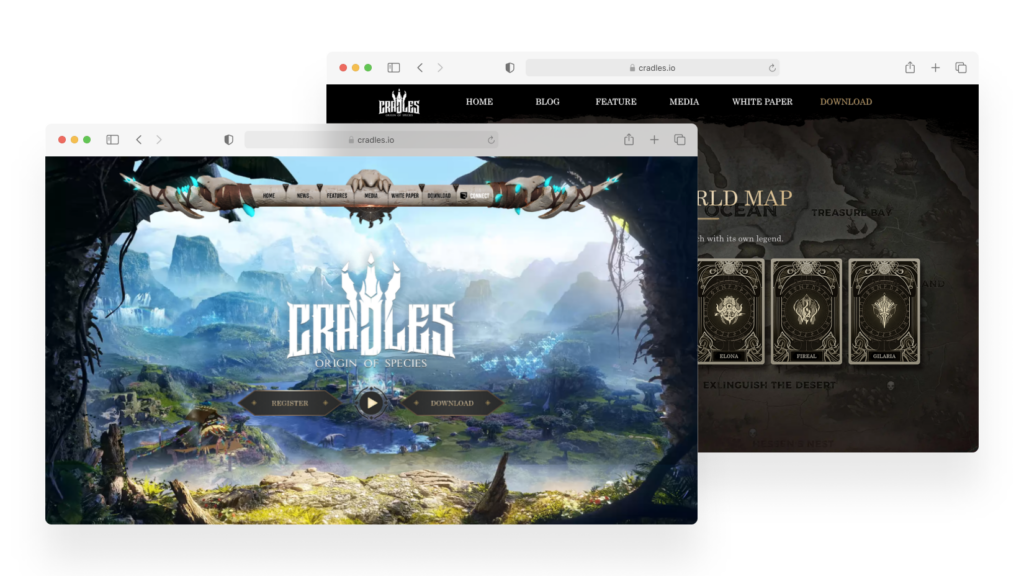
Source steamdb.info
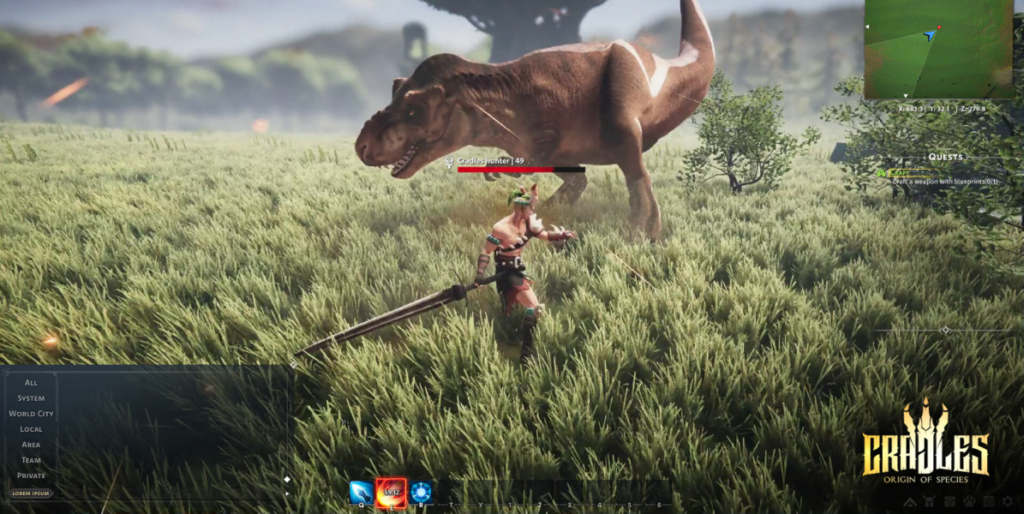
Source steamdb.info
Cradles is a subscription-based blockchain game that is set in a prehistoric virtual world where players decide what happens in the ecosystem as time passes. The game has an entropy system, which provides a realistic aging effect. The entropy system is made possible via a newly proposed token standard dubbed the EIP-3664 protocol. The protocol, which was suggested by DRepublic, will add a time attribute to all in-game assets that can be collected during gameplay. Players can explore the environment and create new experiences, discovering scarce resources, hunting beasts, engaging with other players in combat, and obtaining supplies. The game has five main game modes: Novice Missions, City Governance, Ecosystem Governance, PvP, PvE, and Homeland Defense War[11][12].
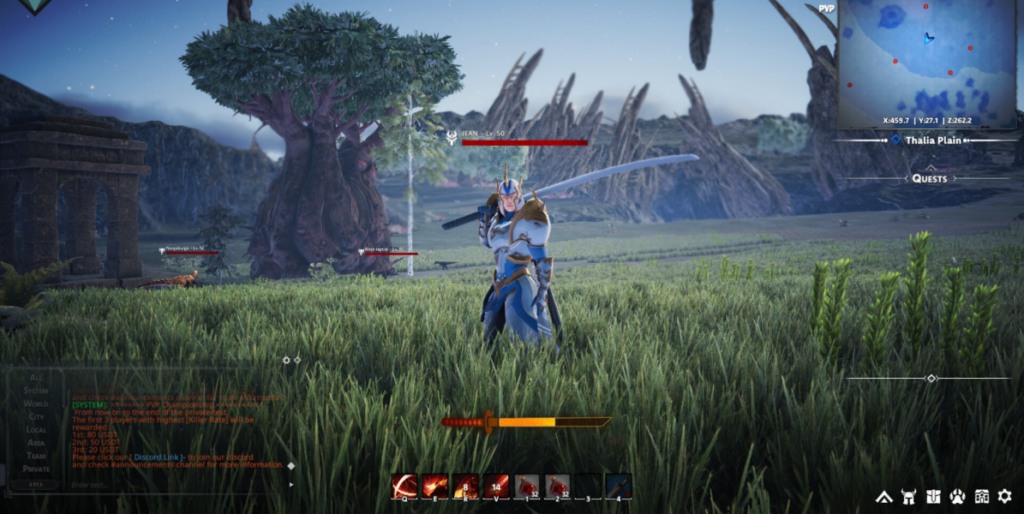
Source steamdb.info
Elemental Raiders
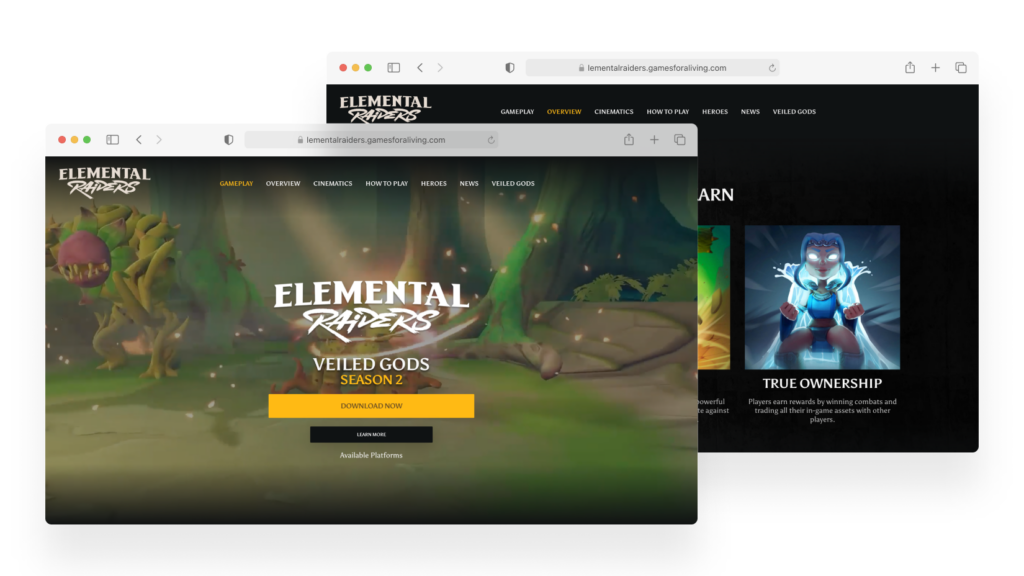
Source steamdb.info
Elemental Raiders is a free-to-play turn-based hero battler game that combines features from collectible card games and multiplayer RPGs. The game is built on blockchain technology, which enables web3 features such as play-to-earn mechanics and NFT integration. Players assemble a team of three heroes from Fire, Water, or Nature elements and create the best deck of skills to fight against raid bosses and other players in the Arena. By defeating opponents, players receive rewards that can be traded in the marketplace[13].
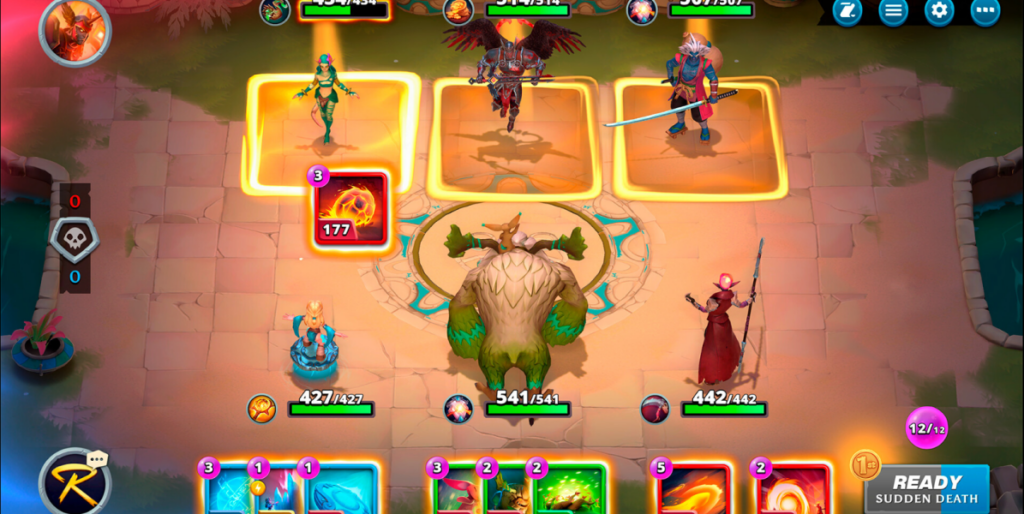
Source steamdb.info
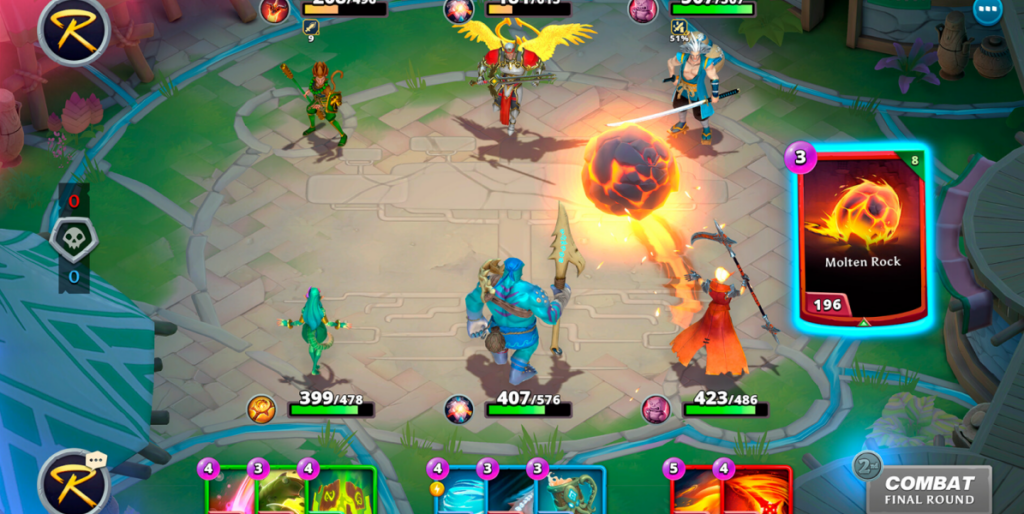
Source steamdb.info
The game offers both PvE and PvP scenarios, with PvE missions allowing players to battle against computer-controlled enemies. Elemental Raiders also features a Play-and-Earn economy, where users can monetize their time by playing the game and selling their progression to other players in the marketplace using the unique system of NFTs. Seasonal rewards in $GFAL tokens are distributed among top-rated players to incentivize the best players in the game[14].
Common Web3 games problems
Web3 gaming faces several infrastructure problems that need to be addressed to reach its full potential. Here are some of the common infrastructure problems faced by Web3 games:
Scalability
One of the major challenges in Web3 gaming is scalability. Current blockchain networks limit the speed and number of transactions, leading to slow and expensive transactions[17][18]. Developers are exploring layer 2 solutions to increase blockchain speed and scalability[17].
Technical Complexity
The technical complexity of Web3 gaming poses a barrier to entry for game developers unfamiliar with blockchain[18]. Web3 infrastructure developers are creating more user-friendly development tools to simplify Web3 game creation[16].
Adoption and User Awareness
User adoption remains a hurdle for the Web3 gaming industry, as many gamers are unfamiliar with blockchain[15][19]. Developers are working on more user-friendly interfaces and educational resources to promote Web3 gaming[17].
Regulation and Legal Challenges

The lack of clarity around regulatory and legal issues creates uncertainty for developers and investors in Web3 gaming[20]. Developers are collaborating with regulators to create a clear legal landscape and standardized development frameworks[20].
Lack of Practical and Easy-to-Use Tools for Game Development
The absence of easy-to-use tools limits developers in creating Web3 games, slowing industry growth[18][19]. Developers are creating user-friendly tools (SDKs and APIs) and educational resources to facilitate Web3 game development[18].
In conclusion, the infrastructure of Web3 gaming is at the nexus of multifaceted challenges that touch upon both technical and non-technical realms. The scalability constraints that currently plague blockchain networks not only affect transaction speed, but also have implications on the real-time gaming experience. Technical complexity presents a formidable barrier to developers, requiring a more nuanced approach to integration and design. Meanwhile, user adoption and awareness remain embryonic, demanding increased education and accessibility. Regulatory uncertainty and the lack of standardized, easy-to-use development tools further compound these challenges. Nevertheless, the ongoing efforts to enhance interfaces, create user-centric tools, foster educational resources, and engage in meaningful regulatory collaboration signal a positive trajectory. The coordinated advancement in these areas has the potential to usher in a new era of Web3 gaming, making it more accessible, enjoyable, and efficient. Future research and development in these directions will likely pave the way for a more robust and innovative Web3 gaming ecosystem.
Web3 Gaming Infrastructure
Web3 gaming infrastructure represents a paradigm shift in the gaming industry, introducing a complex but highly efficient set of technologies and components. This framework leverages the decentralized nature of blockchain to create a new era of gaming where players have more control, security, and transparency. Here is an overview of the primary components:
Blockchain
Blockchain technology serves as the core foundation of Web3 gaming infrastructure[21][22][24]. It facilitates decentralized ownership of in-game assets and currencies, enabling players to trade and monetize their assets. Beyond mere decentralization, blockchain guarantees enhanced transparency, security, and democratization of in-game assets. Crucially, the choice of the correct blockchain is imperative, focusing on factors such as security, scalability, transaction costs, and block finalization time[25].
Smart-contracts
Smart-contracts act as coded agreements where terms between parties are directly embedded within lines of code[22][24]. In Web3 gaming, they automate and secure the process of trading in-game assets and currencies. By creating a trusted environment, smart-contracts significantly enhance transparency and reduce risks[23]. NFTs, or Non-Fungible Tokens, are a special form of smart-contracts that have become central to the intersection of blockchain and gaming[26].
Digital Wallets

Digital wallets in Web3 gaming are used for storing and managing in-game assets and currencies. They serve as secure and efficient tools for transactions, allowing players to purchase, trade, and engage in decentralized gaming platforms[22][22][27].
Game Engines
Game engines play a vital role in the Web3 gaming ecosystem, providing the necessary tools for the creation and deployment of decentralized games[21]. Leading engines like Unity and Unreal Engine, as well as others like CryEngine and Open 3D Engine, enable the development of engaging and interactive decentralized games. These engines are pushing towards seamless integrations with blockchain, which will be instrumental in shaping the future landscape of Web3 gaming[28][29].
Conclusion
The Web3 gaming infrastructure, composed of blockchain, smart-contracts, digital wallets, and game engines, signals a transformative moment in the gaming industry. These components synergize to provide decentralized ownership, robust security, absolute transparency, and unprecedented gameplay experience.
Scalability-focused blockchains
Web3 gaming infrastructure refers to the underlying technology and components that enable Web3 games to function. Scalability-focused blockchains are essential for supporting the growing demand for Web3 games, as they provide security, high scalability, low transaction costs, and fast block finalization times. Some examples of such blockchains include Immutable, Fuse, and SCALE.
zk-Rollups and Immutable
zk-Rollups are a layer-2 scaling solution that can significantly improve the performance of web3 gaming applications. By batching transactions off-chain and only submitting the proof of the transactions to the main network, zk-Rollups dramatically increase transaction capacity, lower transaction fees, and maintain the security provided by the underlying blockchain, such as Ethereum[30].
Immutable is a prominent example of a zk-Rollup solution specifically designed for web3 gaming. It has two L2 products using a different zk-Rollup approach: Immutable X powered by StarkWare and Immutable zkEVM powered by Polygon.
Table 1 – High level comparative analysis of Immutable zkEVM and Immutable X[31].
| Criteria | Immutable zkEVM | Immutable X |
|---|---|---|
| Custom smart-contracts | + | – |
| Ethereum security | + | + |
| Gas fees | Small gas fee per transaction with low friction for gamers | Zero gas fees |
| Game mechanics and tokenomic functionalities | Advanced, by using custom smart-contracts | Limited, by using only ERC721 and ERC20 tokens. |
| Proof systems | zk-SNARKs | zk-STARKs |
| Throughput capabilities | 2,000 TPS | 9,000 TPS |
Building on Immutable gives access to a one-stop-shop toolset for creating compelling web3 games. Unlike many blockchains that focus only on the protocol layer, Immutable invests in both the blockchain and platform layers to ensure an excellent experience for both players and developers. This includes tools like Immutable Passport, a leading wallet for web3 games that eliminates wallet fragmentation, and Immutable Checkout, designed to facilitate a smoother transaction experience across all web3 wallets, and other SDKs and APIs.
zk-Rollup comparison
Immutable X and Immutable zkEVM represent the forefront of layer-2 scaling solutions in the context of Web3 gaming infrastructure. Developed by Immutable, these solutions are constructed to cater to different sectors within the gaming and non-fungible token (NFT) ecosystems.
Immutable X: A Layer-2 Scaling Solution for NFTs
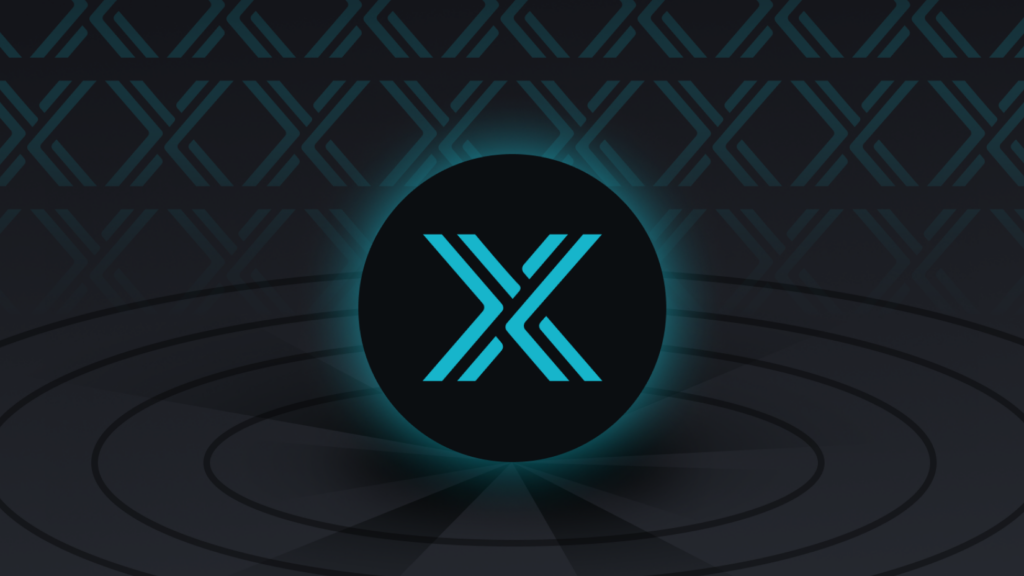
Immutable X is primarily designed to facilitate non-fungible tokens (NFTs) on the Ethereum network. Its objective is to enhance the scalability and overall user experience of Ethereum by offering rapid transaction confirmation and almost negligible gas fees for both minting and trading NFTs[32]. Utilizing Zero-Knowledge Rollup technology, it can support up to 9,000 transactions per second, making it suitable for games that require high performance at low cost without compromising Ethereum’s security[31].
Key Attributes of Immutable X
- Scalability – Capable of supporting up to 9,000 transactions per second[32].
- Economical Gas Fees – Significantly reduces the cost associated with minting and trading NFTs[32].
- Prompt Transaction Confirmation – Enhances user experience through instant confirmation[32].
- Ethereum Security – Ensures the security and integrity of users’ assets[32].
Immutable zkEVM: A Chain Designed for Game Development
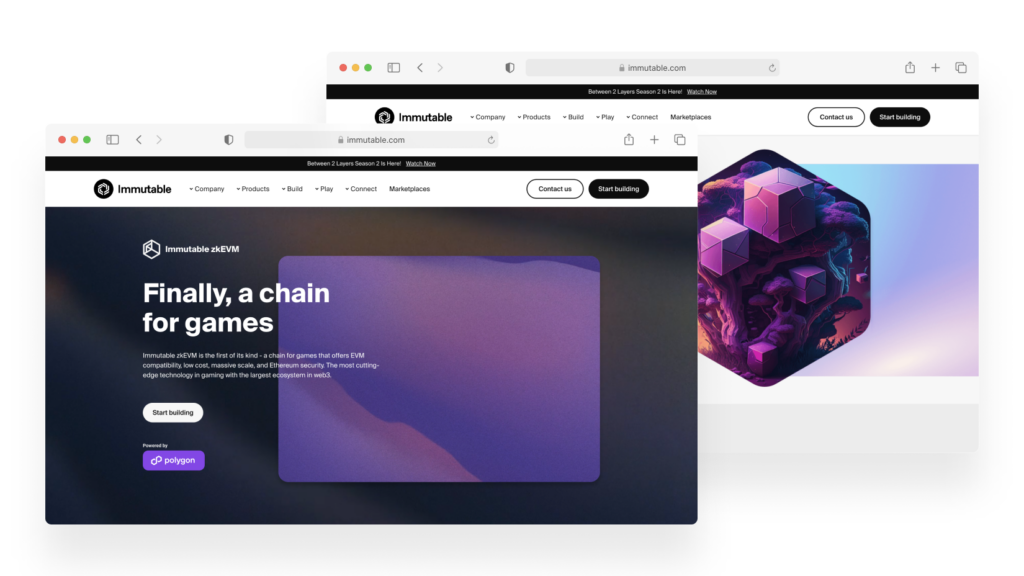
Immutable zkEVM, on the other hand, offers compatibility with the Ethereum Virtual Machine (EVM) and provides a cost-effective, large-scale, and secure environment specifically engineered for game development[31]. By leveraging Polygon’s zkEVM technology, it affords a more economical and efficient transaction process compared to the Ethereum mainnet[33]. It is ideally suited for developers aiming to create rich gaming experiences with customized smart-contracts and intricate on-chain mechanics[31].
Key Attributes of Immutable zkEVM
- EVM Compatibility – Facilitates the utilization of Ethereum’s smart-contract functionalities[31].
- Low Transaction Cost – Offers reduced transaction costs for developers and players alike[31].
- Substantial Scalability – Maintains the ability to handle large numbers of transactions without security compromises[31].
- Ethereum Security – Assures the protection and integrity of users’ assets and transactions[31].
Conclusion
Immutable X is strategically focused on delivering a scalable and cost-efficient solution tailored for NFTs on the Ethereum network. Conversely, Immutable zkEVM is crafted with an emphasis on game development, complete with advanced web3 game mechanics and smart-contract functionalities. While both solutions are dedicated to augmenting the user experience and scalability of Ethereum-based applications, their specific orientation towards different use cases within the gaming and NFT landscapes delineates their unique contributions.
Fuse
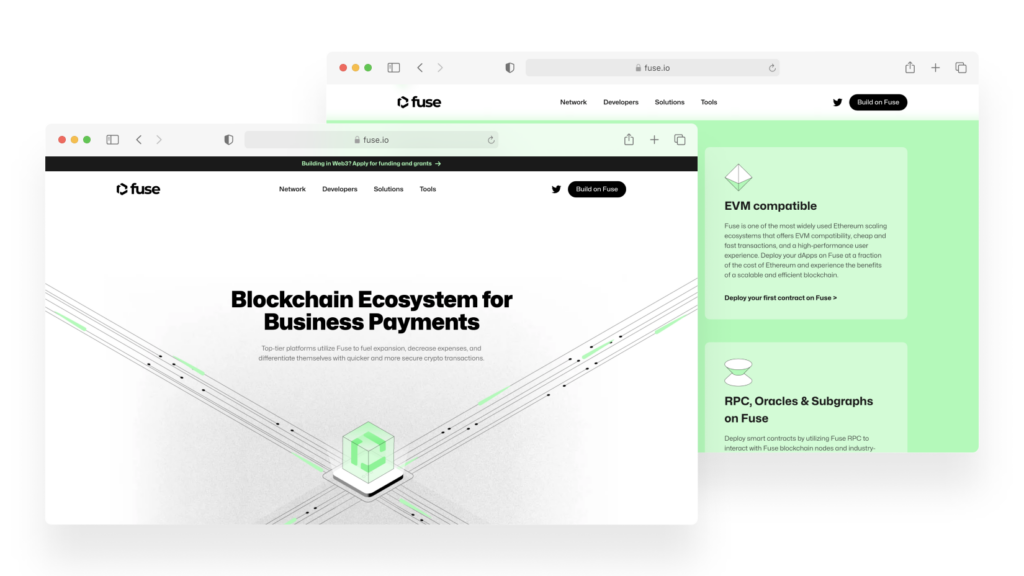
Fuse represents a decentralized public blockchain of enterprise-grade quality that is compatible with the Ethereum Virtual Machine (EVM). This platform aims to facilitate Web3 payments and enable businesses to fully exploit this functionality[36]. The primary emphasis of Fuse is the provision of an infrastructure that is scalable, efficient, and economical for Web3 applications, addressing both businesses and individual consumers. It maintains a strong focus on sustaining high transaction volumes while ensuring robust security and decentralization[37].
Table 2 – Fuse Technology [39]
| Criteria | Description |
|---|---|
| Security | Fuse Network uses a delegated proof-of-stake consensus mechanism, which ensures the security and decentralization of the network. |
| Throughput | Although the Fuse Network blockchain is not currently experiencing any issues with transaction throughput, the team is investing substantially in scaling for higher performance. |
| Transaction Costs | Transactions on the Fuse blockchain cost as little as $0.001, making it an affordable option for various applications. |
| Block Finalization Time | The Fuse Network blockchain has an average block interval of 5 seconds, which means that transactions can be considered finalized after just one block confirmation. |
Benefits for Web3 Gaming
- Scalability – The Fuse Network offers scalable solutions that suit real-world applications, allowing decentralized applications (dApps) to leverage rapid transaction speeds and low costs in order to expand and engage their user bases[36].
- Wallet as a Service – Fuse facilitates Wallet as a Service via its Smart Wallets API. This allows organizations to design and launch fully customizable on-chain wallets for their user base[35]. Such functionality can enable web3 gaming platforms to integrate crypto payments and wallet systems with ease.
- EVM Compatibility – As it’s EVM-compatible, the Fuse Network can be integrated effortlessly with existing Ethereum-based gaming dApps and platforms[34].
- Low Transaction Costs – The Fuse Network’s minimal transaction costs render it an appealing choice for web3 gaming platforms, making in-game transactions and microtransactions more affordable[34].
Digital Wallet
Through its Smart Wallets API, Fuse offers Wallet as a Service, enabling organizations to develop and launch bespoke on-chain wallets[35]. In addition, Fuse can successfully be added to any wallet which supports Ethereum (like Metamask).
Ecosystem
The Fuse Network has successfully attracted over 100 decentralized service providers, or operators, who have introduced their dApps on the platform, constituting part of an extensive ecosystem[38]. These dApps span various industries, encompassing gaming, mobile payments, non-fungible tokens (NFTs), decentralized exchanges (DEXs), and token bridges, among others.
SDK and API Variety for Different Game Engines
Fuse provides a Software Development Kit (SDK) to assist developers in creating, managing, and engaging with Fuse Smart Wallets within their Flutter and TypeScript applications. While there are no specific SDKs and APIs for game engines provided by Fuse, there are common EVM libraries for game engines that are compatible with Fuse.
Reliability
Investors and team
Fuse has attracted significant investment, reaching a peak market capitalization of nearly $300 million. Fuse has a strong team focused on innovation and user experience, which has contributed to the project’s growth trajectory[40].
Technology and Security Assessment
Fuse Network uses a delegated proof-of-stake consensus mechanism, ensuring the security and decentralization of the network. The network has facilitated over 120 million transactions across 1.35 million wallets since its inception in 2019[40].
Conclusion
Though not expressly de nonsigned for Web3 gaming, Fuse Network offers a scalable blockchain solution applicable to in-game financial functions. The platform’s primary goal is to deliver a rapid, secure, and cost-efficient infrastructure tailored to Web3 applications, with a particular focus on the DeFi ecosystem. With attributes such as EVM compatibility, minimal transaction costs, and scalability, the Fuse Network presents an attractive option for web3 gaming platforms contemplating the integration of crypto payments and wallets. However, it must be recognized that the network presently lacks a dedicated gaming ecosystem and SDKs specifically tailored for gaming. In summary, while Fuse Network may not represent the perfect choice for Web3 gaming infrastructure, its various features and capabilities can certainly be employed for in-game financial operations and other related applications.
SKALE
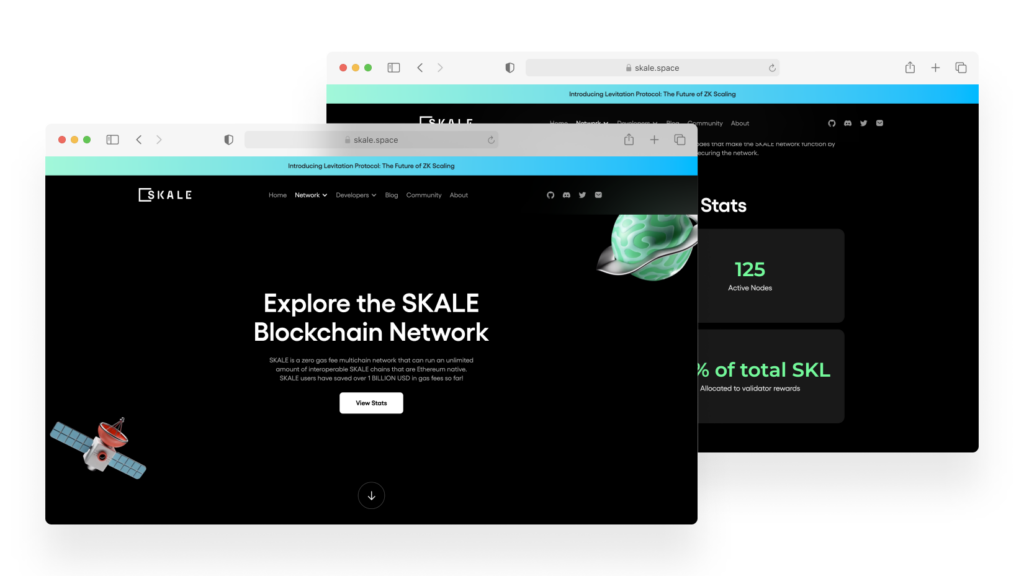
SKALE is an innovative, Ethereum-native, modular blockchain network meticulously engineered to deliver high-throughput, low-latency, and zero gas fee transactions. It represents a fully decentralized, open-source, and community-owned initiative, targeting the enhancement of scalability for Ethereum decentralized applications (dApps), including NFT platforms, games, and a variety of Web3 applications[41].
Table 3 – SKALE Technology [41][43].
| Criteria | Description |
|---|---|
| Security | Constructed in synergy with Ethereum, SKALE offers robust security and reliability to the network. The integration with Ethereum’s mainnet provides unparalleled customization, horizontal scaling, and further fortifies the security framework. |
| Throughput | SKALE is capable of supporting a large volume of transactions at minimal costs while maintaining high security. However, the baseline of 400 transactions per second (tps) and up to 700 tps at peak which may not be enough for large games. |
| Transaction Costs | End-users are exempt from gas fees in SKALE’s economic model, as developers shoulder the costs associated with space and chain resources. This model alleviates users from traditional burdens tied to gas fees. |
| Block Finalization Time | Equals to block generation time ~ 3-4 sec. |
Benefits for Web3 Gaming
- Zero Gas Fees for Users: Developers assume costs, enhancing accessibility for a diverse user base.
- Flexible Architecture: Offering a choice between dedicated chains or specialized hubs for optimal resource allocation and scaling.
- Faster Commit Times: Block finalization time on SKALE network equals to block generation time.
Digital Wallet and SDK software
SKALE doesn’t provide their own wallets, SDK or API for game development. However, compatibility with Ethereum suggests various crypto wallets (for web – Metamask, Trust Wallet) as well as various SDK software that enables potential integration with game engines.
Ecosystem
SKALE’s ecosystem embodies a vibrant assembly of developers, validators, and projects. It comprises a diverse range of applications, including gaming platforms and Web3 applications. The SKALE Innovator Program extends support through grants, consultations, marketing, engineering, QA, and investor introductions[44].
Reliability
Investors and Team
SKALE’s team is an amalgamation of experts from the United States and Ukraine, encompassing management, finance, and technical domains. Investments from reputable stakeholders further accentuate the project’s credibility [41].
Technology and Security Assessment
Employing a sophisticated combination of enterprise-level security measures, SKALE ensures the safety and integrity of the network. The Proof-of-Stake consensus mechanism and the integration with the Ethereum mainnet contribute to its robust security landscape [43].
Examples of Games Launched
A selection of games on the SKALE network exemplify its capabilities in offering a frictionless gaming experience[42]:
- Untitled Platformer
- CryptoBlades
- Gamifly
These offerings showcase SKALE’s potential in rendering zero gas fees and high throughput for Web3 gaming, underscoring its position as a promising solution in the space.
Conclusion
In conclusion, the SKALE blockchain network offers a promising solution for Web3 gaming infrastructure by providing low-latency, and zero gas fee transactions. Its Ethereum-native, modular architecture ensures robust security and scalability, making it a worthy choice for decentralized applications, including games and NFT platforms. SKALE’s ecosystem supports a diverse range of applications and offers various resources for developers through the SKALE Innovator Program. With successful game launches like Untitled Platformer, CryptoBlades, and Gamifly, SKALE demonstrates its potential in delivering seamless gaming experiences and fostering innovation in the Web3 gaming space.
Comparative summary
Web3 gaming, underpinned by decentralization and blockchain, is a paradigm shift that demands novel infrastructure solutions to realize its full potential. Within this dynamic, scalability-focused blockchains emerge as the linchpin, providing the requisite performance, security, and affordability.
The foray into zk-Rollups, with platforms like Immutable, exemplifies a holistic approach to Web3 gaming. The stark contrasts between Immutable X and zkEVM spotlight the specialization inherent within the domain. Immutable X, being primarily NFT-focused, offers vast throughput capabilities and negligible fees, whereas Immutable zkEVM is architecturally tailored for intricate game mechanics. Such diversity is commendable, ensuring game developers and players have a suite of tailored solutions to cater to their distinct needs. All of this makes Immutable the leading platform for Web3 game development.
While Immutable channels its efforts primarily into the gaming realm, Fuse and SKALE have broader horizons. Fuse, with its DeFi inclination, nonetheless offers key attributes like low transaction costs and EVM compatibility, which can be harnessed for in-game financial mechanisms. However, its present ecosystem may require more gaming-specific integrations to be a forerunner in this niche.
SKALE, on the other hand, resonates deeply with the gaming spirit. With zero gas fees, high throughput, and an arsenal of games already launched, it aptly showcases its prowess as a robust Web3 gaming solution. The emphasis on Ethereum-native constructs ensures SKALE’s alignment with the prevailing blockchain ecosystem, thereby making integrations smoother.
In sum, for Web3 gaming to thrive, the focus must be on platforms that offer the dual advantage of security and performance. While Ethereum’s layer-1 might set the foundation, the true scalability and user experience enhancements are promised by layer-2 solutions like zk-Rollups. Among these, Immutable, with its dedicated SDKs and APIs for game development, emerges as a particularly promising avenue. For developers and investors alike, aligning with platforms that emphasize both technological innovation and user-centricity will be pivotal in unlocking the next frontier of gaming.
SDK and API – blockchain wrappers
Web3 gaming refers to the use of blockchain technology in video games, which unlocks new revenue models and reduces development time[45]. SDKs (Software Development Kits) and APIs (Application Programming Interfaces) are essential tools for web3 game development. SDKs simplify blockchain integration by abstracting domain-specific logic into simple interfaces, enabling non-blockchain developers to understand and utilize them efficiently[46]. APIs allow web3 games to communicate with the blockchain to perform various functions, such as reading data, sending data, checking asset-related transactions, and more[48].
SDKs and APIs are crucial for web3 game development because they:
- Expedite development cycles and ensure adherence to best practices[46].
- Enable seamless integration of blockchain, crypto, and web3 capabilities[49].
- Provide cost savings and allow game teams to focus on their core expertise[46].
- Support popular game engines like Unity and Unreal[49].
- Facilitate easy integration of web3 wallets for in-game transactions[50].
- Support web3 wallets for in-game transactions[47].
- Integrating NFT capabilities like minting, renting, and trading[47].
- Optimize games for web3 on mobile devices[47].
Ankr’s Gaming SDK
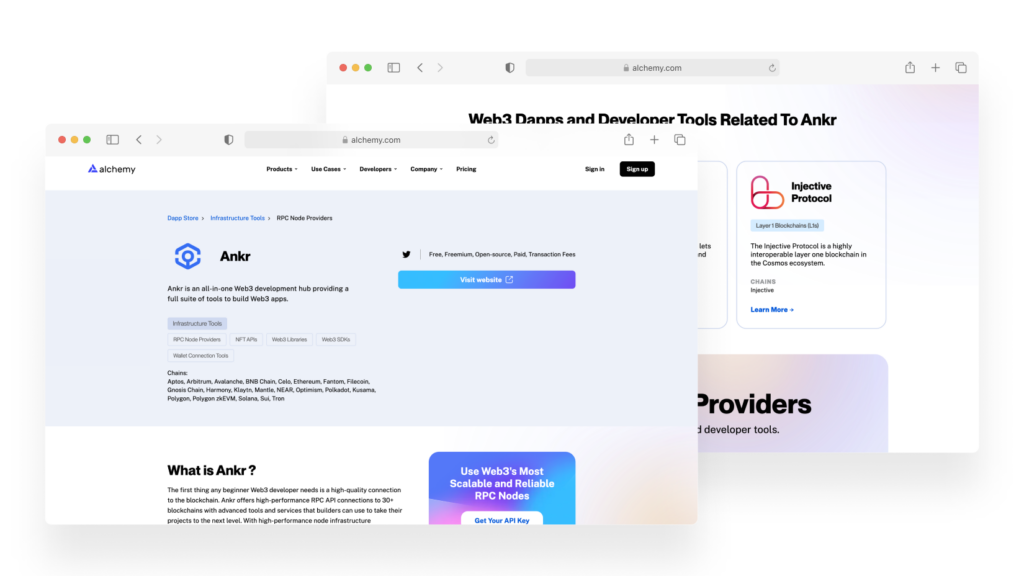
Ankr SDK is a game development toolkit designed for developers looking to implement Web3 capabilities in existing or new games. It is compatible with leading gaming engines such as Unity and Unreal Engine. The SDK enables seamless interactions with Web3 wallets, EVM-supported blockchains, decentralized exchanges, lending platforms, and staking services. Ankr SDK helps game developers integrate their games with multiple chains[51].
Ankr’s Gaming SDK allows developers to:
- Support Web3 wallets for in-game transactions[54]
- Integrate NFT capabilities like minting, renting, and trading[54]
- Launch and distribute in-game currency as tokens[54]
- Optimize games for Web3 on mobile[52]
- Integrate with staking, DEXs, lending applications, and more[50]
Advantages
- Compatibility with popular gaming engines like Unity and Unreal Engine, making it easy for developers to integrate Web3 capabilities into their games[51].
- Provides a comprehensive set of tools for integrating blockchain, crypto, and Web3 capabilities, including NFT marketplaces and multi-chain wallet integrations[50].
- Ankr’s infrastructure offers significant advantages in certain global regions, providing lower latency compared to competitors[53].
- Ankr’s partnership with Mirage enables the development of immersive gaming experiences with unparalleled security, speed, and scalability[55].
- Ankr’s Gaming SDK has free access allowing users to use it in the early stages of game development. Also, it has a Premium plan with Advanced API[56].
Venly
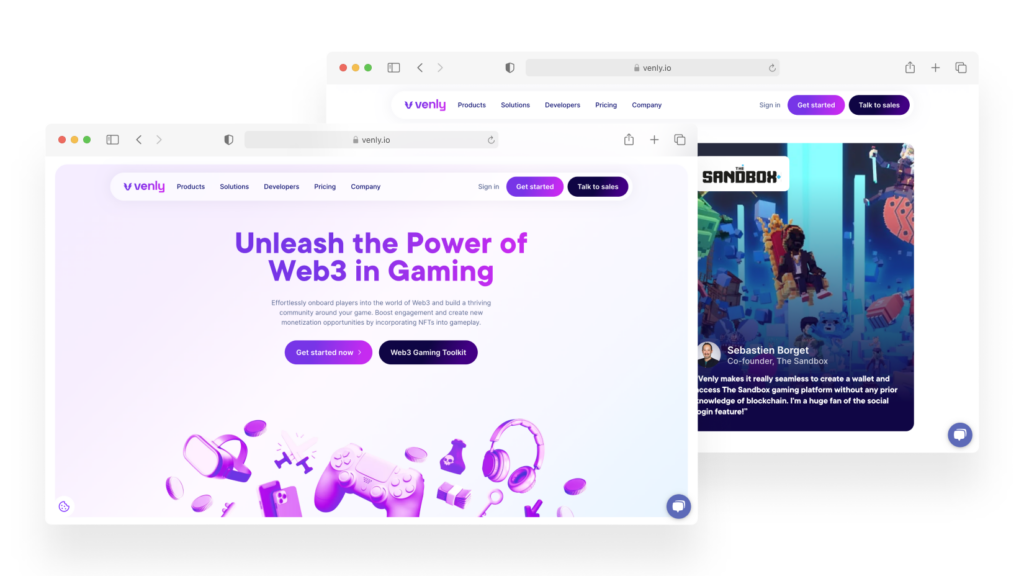
Venly offers a comprehensive Web3 gaming toolkit that provides blockchain and platform-agnostic tools for game developers to create seamless user experiences for players[57]. Their solutions include:
- Unity/Unreal SDK and LiveOps integrations for faster and more flexible development.
- Developer-centric design with a focus on backend service provider agnosticism.
- In-editor tools that eliminate the need to switch tabs.
- API solution to create white-labeled in-game marketplaces with custom UX and UI[57].
Advantages
- Seamless onboarding using social logins[57].
- Mobile-native solutions[57].
- Over 3 million wallets[57].
- Support for multichain and private sales[57].
- Compatibility with popular game engines[57].
- Reliable and easy-to-use marketplace solutions[58].
- They have important customers like Fnatic.
It’s essential to mention that Venly doesn’t provide free access to all of its services, and the prices are relatively high[59].
Sequence Gaming Infrastructure
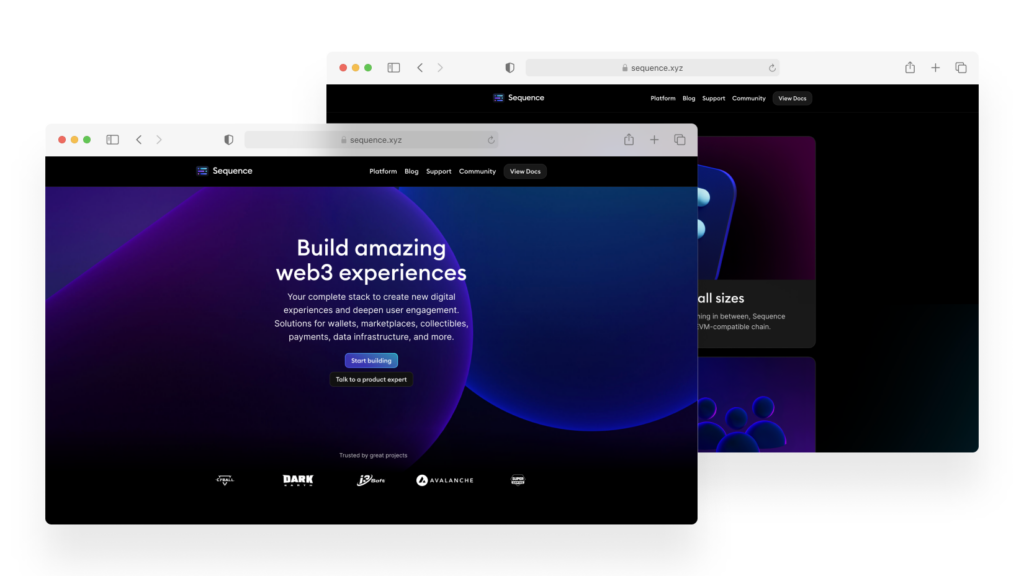
Sequence is an all-in-one web3 developer platform and smart wallet designed to make building web3 games and applications easy[60]. It was created by Horizon, a company focused on making web3 easy, fun, and accessible for users and builders[61]. Sequence provides developers with access to a seamless smart wallet, Token and NFT APIs, Indexer, and Relayer for gasless transactions[60]. It supports Ethereum and EVM-compatible networks as well as game engines like Unity or Unreal Engine.
Advantages
- Ease of use – Sequence simplifies the process of building web3 games and applications, making it more accessible for developers[61].
- Multi-chain support – Sequence works with all EVM-compatible chains, allowing developers and users to leverage the network best suited for their needs[61].
- Seamless smart wallet – Users can create a non-custodial, multi-chain smart-contract wallet in just two clicks, without the need for seed phrases or installations[62].
- NFT and Token APIs – Powerful APIs enable easy integration of NFTs and tokens into applications[62].
- Gasless transactions – The Relayer feature allows for reliable, fast, and gasless transactions, improving user onboarding[62].
- Comprehensive developer tools – Sequence offers a wide range of tools and features to help developers create seamless web3 experiences for users supporting both Unity and Unreal Engine game engines[63].
- Free to use with the ability to buy custom advanced access.
Conclusion
Web3 gaming, ushering in a transformative era in the gaming realm, heavily relies on SDKs and APIs as its linchpins. These tools, acting as efficient ‘blockchain translators’ streamline the fusion of gaming with blockchain tech. Ankr’s Gaming SDK shines with its expansive multi-chain capabilities and free access, making it ideal for a wide spectrum of developers. Venly, with its user-centric design, prioritizes seamless gaming experiences but comes at a premium price. Sequence, meanwhile, offers an all-encompassing toolkit for game developers, marked by its ease of use and gasless transactions.
Case of study: Illuvium
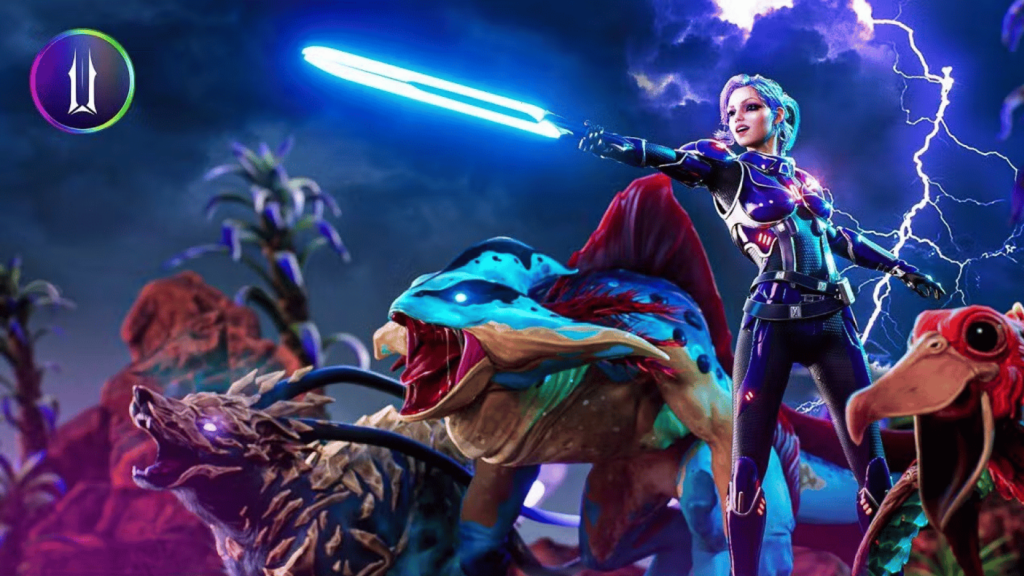
Source steamdb.info
Illuvium is an open-world role-playing game (RPG) built on the Ethereum blockchain, featuring a play-to-earn structure. Players can explore seven different alien worlds, capture, and battle non-fungible token (NFT) creatures called Illuvials, and earn in-game rewards in ILV tokens[64][65]. The game combines elements of classic RPG collection games with battle techniques popularized by the auto battler genre[72].
Infrastructure
Blockchain
Illuvium is built on the Ethereum blockchain and uses Immutable X, a layer-2 scaling solution for NFTs on Ethereum, which provides gas-free transactions[67]. Players can capture Illuvials, which become more powerful as they win battles, and earn ILV tokens as rewards. Illuvials and other in-game items exist in the player’s wallet as NFTs and can be traded on Illuvium’s NFT marketplace, IlluviDEX[65][68].
The in-game economy and governance is built on Blockchain smart-contracts to be secure and transparent. Illuvium uses tokens on the Ethereum blockchain to represent assets within the game that can be created, traded, or burned. Staking and the DAO are currently on L1 Ethereum. The game also features a play-to-earn structure, where users can earn in-game rewards in the form of ILV tokens by engaging in competitions and quests.
Game Engine
The game is developed using Unreal Engine 5, which allows for detailed regions and environments, making it stand out among other blockchain-based games[66][69]. The battles run in a simulation coded in pure C++ that executes the game instances in less than a few milliseconds[66].
SDKs and APIs
Illuvium uses the Alchemy SDK to access NFT API functionality[70]. The game also integrates with the hyper-scalable Immutable X layer-2 solution, which offers zero gas fees for minting or trading assets and sub-second transaction speeds[72]. Illuvium’s in-built decentralized exchange (DEX), IlluviDEX, allows players to exchange their Illuvial assets[71].
Game Economy
Illuvium, a leader in the Web3 gaming space, has pioneered a unique game economy that seamlessly integrates blockchain benefits with gaming.
Fuel is the primary medium of exchange in Illuvium, driving all in-game transactions. Landowners produce this fuel, which they can either use to enhance their plots or sell to other players via the Fuel Pool[75].
Illuvium’s economy is split into:
- Supply Games (e.g., Illuvium Zero and Illuvium Overworld) – These games generate fuel and items. Players gather resources, craft, and create assets for trade or use in other games.
- Demand Games (e.g., Illuvium Arena and Illuvium Beyond) – These games consume the fuel and items from Supply Games, ensuring a continuous demand for resources[75].
While no new Supply Games are on the horizon, more Demand Games are planned to further boost the economy’s demand.
Illuvium’s economy is designed to adjust to supply and demand shifts. If fuel demand surpasses supply, the governing DAO can sell more land plots (up to 100,000) or introduce new game features to increase fuel supply, ensuring market equilibrium[75].
Tokenomics
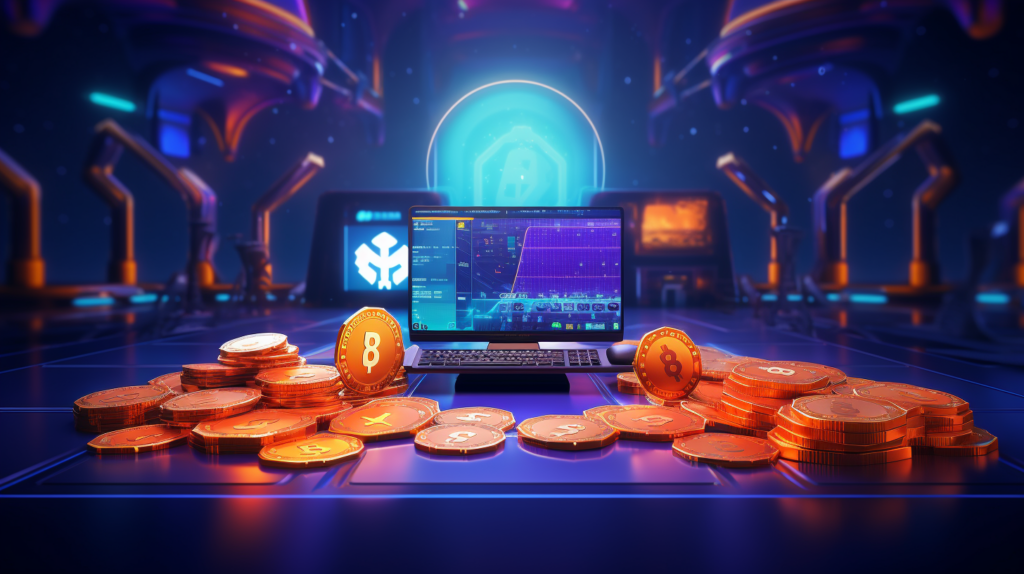
lluvium’s tokenomics revolves around the $ILV token, a multifunctional asset that serves both as a governance tool and a tradable token. As a governance token, it grants holders a voice in the project’s decentralized decisions, allowing them to shape Illuvium’s trajectory. Simultaneously, its economic utility offers real-world value, enabling buying, holding, and trading. Together, these roles make $ILV a pivotal asset, blending community influence with tangible benefits[74].
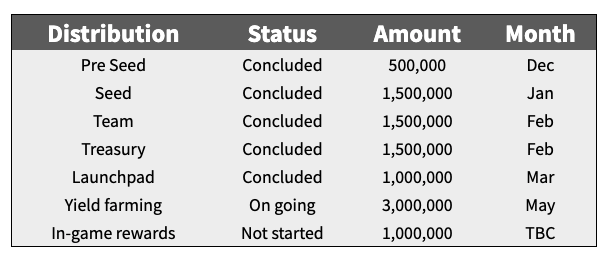 Figure 1 – Historical Token Sale [73]
Figure 1 – Historical Token Sale [73]
Balancer Smart Pool Distribution
Illuvium employed a Balancer Liquidity Bootstrapping Pool (BLBP) for $ILV’s public sale. Unlike standard pools with a 50:50 asset ratio, BLBPs use variable weightings, causing the token price to initially decline from a high value. This dynamic interplay between changing weights and trading activity ensures a fair token price determination. Illuvium distributed up to 1,000,000 $ILV tokens through this method, starting at $50 USD per token[74].
Table 4 – Illuvium Tokenomics[74].
| Aspect | Description |
|---|---|
| Treasury and DAO | The Treasury, a significant part of the Illuvium DAO, represents the collective interests of token holders. It has the power to allocate funds for game development and hire third-party services, ensuring the project’s growth while adhering to decentralization principles. |
| Vault Mechanism | The Vault collects all game-generated revenue. It then buys ILV tokens from the open market and distributes them among token holders, ensuring a fair share of the game’s profits and incentivizing continued participation. |
| Yield Farming | Yield Farming rewards staked token holders based on factors like lock duration and the number of tokens staked. This mechanism promotes long-term token holding and ecosystem stability. |
| Distributions | Distributions arise from the Vault’s actions, converting game revenue into ILV tokens. These distributions reward token holders for their involvement, reinforcing the ecosystem’s health and the project’s commitment to its community. |
Conclusion
Illuvium stands as a beacon in the Web3 gaming landscape, masterfully intertwining state-of-the-art graphics, intricate game mechanics, and the transformative power of blockchain technology. Built atop the Ethereum blockchain and enhanced by the Immutable X layer-2 solution, it offers players gas-free transactions and a dynamic marketplace for trading NFTs, such as the coveted Illuvials. The utilization of Unreal Engine 5 not only elevates the visual experience but sets a new standard for immersion in blockchain games. With its play-to-earn model and the deep integration of NFTs into its core gameplay, Illuvium doesn’t just follow trends—it sets them, solidifying its position as a trailblazer in the blockchain gaming realm.
Summary

The digital gaming landscape is undergoing a transformative shift with the advent of Web3 gaming infrastructure. Central to this transformation is the synergy of blockchain, smart-contracts, digital wallets, and game engines. Together, these components promise a gaming experience marked by decentralized ownership, robust security, and unparalleled transparency.
The research delves into various platforms, each offering unique solutions to the challenges of Web3 gaming. Immutable stands out with its dual offerings: Immutable X, tailored for NFTs, and Immutable zkEVM, designed with game development in mind. Both platforms, while serving different niches, underscore the versatility required in the evolving Web3 gaming landscape, and as a result being the leading platform for Web3 game development. Fuse Network, though primarily DeFi-oriented, presents potential for in-game financial operations, given its low transaction costs and EVM compatibility. However, its broader focus might necessitate more gaming-specific integrations in the future. SKALE emerges as a strong contender in the Web3 gaming arena, with its zero gas fees, and a proven track record of successful game launches.
The role of SDKs and APIs as ‘blockchain translators’ is pivotal in the seamless integration of gaming and blockchain. Platforms like Ankr, with its multi-chain capabilities, and Venly, with its user-centric design, offer varied solutions catering to different developer needs. Sequence stands out with its comprehensive toolkit, ensuring ease of use and gasless transactions.
In conclusion, the future of gaming lies at the intersection of technological innovation and user-centricity. As the industry navigates the challenges and opportunities of Web3, platforms that prioritize both scalability and user experience will shape the next frontier of gaming. The research underscores the need for continued exploration, development, and collaboration to harness the full potential of Web3 gaming infrastructure.
References
- Web3 Gaming and Content Creation: NFTs and the Creator Economy – Blockchain Magazine (online). Accessed 8.08.2023. Available: https://blockchainmagazine.net/web3-gaming-and-content-creation-nfts-and-the-creator-economy/
- Web3 Gaming – Hedera Hashgraph (online). Accessed 9.08.2023. Available: https://hedera.com/learning/gaming/web3-gaming
- Blockchain Blitz: Gaming & Web3 – Outsider Gaming (online). Accessed 9.08.2023. Available: https://outsidergaming.com/blockchain-blitz-gaming-web3/
- Pursuing the Holy Grail of Web3 Game Interoperability – BITKRAFT Ventures (online). Accessed 9.08.2023. Available: https://www.bitkraft.vc/pursuing-the-holy-grail-of-web3-game-interoperability/
- Overview of Web3 Play-to-Earn Games – Pontem Network (online). Accessed 9.08.2023. Available: https://pontem.network/posts/overview-of-web3-play-to-earn-games-2
- How Gaming, Loyalty and Entertainment Are Adapting to the Rise of NFTs and Web3 – CoinDesk (online). Accessed 9.08.2023. Available: https://www.coindesk.com/web3/2023/06/23/how-gaming-loyalty-and-entertainment-are-adapting-to-the-rise-of-nfts-and-web3/
- Web3 Gaming: Decentralization in the Gaming World – Queppelin (online). Accessed 9.08.2023. Available: https://www.queppelin.com/web3-gaming-decentralization-in-the-gaming-world/amp/
- The Cybersecurity Role in Web Gaming Adoption – BeInCrypto (online). Accessed 10.08.2023. Available: https://beincrypto.com/cybersecurity-role-web-gaming-adoption/
- Harnessing the Power of Interoperability in Web3 Gaming: Advantages, Challenges, and the Path Ahead – CP Group Official (online). Accessed 10.08.2023. Available: https://medium.com/@CPGroupOfficial/harnessing-the-power-of-interoperability-in-web3-gaming-advantages-challenges-and-the-path-ahead-bd8cb274e550
- Unleashing the Power of Play-to-Earn: A Guide to Web3 Gaming Rewards – GGEM GameHub (online). Accessed 10.08.2023. Available: https://medium.com/@ggem-gamehub/unleashing-the-power-of-play-to-earn-a-guide-to-web3-gaming-rewards-a7173ec95e47
- Cradles | Prehistoric Metaverse (online). Accessed 28.08.2023. Available: https://www.cradles.io/
- How to Play and Win: Cradles: Origin of Species – DappRadar (online). Accessed 28.08.2023. Available: https://dappradar.com/blog/how-to-play-cradles-origin-of-species-blockchain-game
- Elemental Raiders | The best new Free-To-Play strategy game (online). Accessed 28.08.2023. Available: https://elementalraiders.gamesforaliving.com/
- Elemental Raiders White Paper: About Elemental Raiders (online). Accessed 28.08.2023. Available: https://whitepaper.elementalraiders.com/
- Problems that plague today’s Web3 games – Sankalp Shangari – LinkedIn (online). Accessed 11.08.2023. Available: https://www.linkedin.com/pulse/problems-plague-todays-web3-games-sankalp-shangari
- Challenges in Web3 Gaming – Tevaera (online). Accessed 11.08.2023. Available: https://www.linkedin.com/pulse/challenges-web3-gaming-tevaera
- The Rise of Web3 Gaming: Opportunities and Challenges – EAK Digital (online). Accessed 11.08.2023. Available: https://eakdigital.com/the-rise-of-web3-gaming-opportunities-and-challenges/
- Problems in Web3 Gaming Ecosystem, Future Marketcap and Trikon’s Solution – Young_3xpert – Medium (online). Accessed 11.08.2023. Available: https://medium.com/@Young_3xpert/problems-in-web3-gaming-ecosystem-future-marketcap-and-trikons-solution-56ca28d81eb
- Challenges in the Current Web3 Gaming Ecosystem and How Trikon is Addressing Them – Avie018 – Medium (online). Accessed 11.08.2023. Available: https://medium.com/@avie018/challenges-in-the-current-web3-gaming-ecosystem-and-how-trikon-is-addressing-them-1e0d539f6709
- Blockchain Gaming and Its Three Important Challenges – Juego Studio (online). Accessed 11.08.2023. Available: https://www.juegostudio.com/blog/blockchain-gaming-and-its-three-important-challenges
- Key Factors to Consider When Choosing a Web3 Game Development Company – Supply Chain Game Changer (online). Accessed 11.08.2023. Available: https://supplychaingamechanger.com/key-factors-to-consider-when-choosing-a-web3-game-development-company/
- Ethereum vs Polygon for Web3 Gaming – CryptoStars (online). Accessed 12.08.2023. Available: https://blog.cryptostars.is/ethereum-vs-polygon-for-web3-gaming-466ee7b1b317
- What is Web3 Gaming? – LeewayHertz (online). Accessed 12.08.2023. Available: https://www.leewayhertz.com/what-is-web3-gaming/
- The Role of Wallet in Web3 – 0xsequence (online). Accessed 12.08.2023. Available: https://medium.com/0xsequence/role-wallet-web3-696732495eac
- How to Choose the Right Blockchain for Your Game – Zeeve (online). Accessed 12.08.2023. Available: https://www.zeeve.io/blog/how-to-choose-the-right-blockchain-for-your-game/
- From Controllers to Smart Contracts: How Gaming is Evolving with Web3 – Moongate (online). Accessed 12.08.2023. Available: https://www.moongate.one/blogs/from-controllers-to-smart-contracts-how-gaming-is-evolving-web3
- Blockchain in Gaming: Revolutionizing the Gaming Industry – Appinventiv (online). Accessed 12.08.2023. Available: https://appinventiv.com/blog/blockchain-in-gaming/
- Web3 Game Development: The Next Frontier in Online Gaming – Antier Solutions (online). Accessed 12.08.2023. Available: https://www.antiersolutions.com/web3-game-development-the-next-frontier-in-online-gaming/
- Coinbase Simplifies Entry to Web3 with Wallet-as-a-Service – PYMNTS.com (online). Accessed 14.08.2023. Available: https://www.pymnts.com/mobile-wallets/2023/coinbase-simplifies-entry-web3-with-wallet-as-a-service/
- Why Immutable zkEVM is the Next Frontier in Web3 Game Development – Immutable (online). Accessed 14.08.2023. Available: https://www.immutable.com/blog/why-immutable-zkevm-is-the-next-frontier-in-web3-game-development
- Immutable zkEVM – Immutable (online). Accessed 14.08.2023. Available: https://www.immutable.com/products/immutable-zkevm
- What is Immutable X (IMX)? – Binance Academy (online). Accessed 14.08.2023. Available: https://academy.binance.com/en/articles/what-is-immutable-x-imx
- EF Defense: Tower Defense Mobile Game Launching on Immutable zkEVM – Decrypt (online). Accessed 14.08.2023. Available: https://decrypt.co/150330/ef-defense-tower-defense-mobile-game-launching-immutable-zkevm
- An Overview of the Fuse Network – Coinmonks (online). Accessed 14.08.2023. Available: https://medium.com/coinmonks/an-overview-of-the-fuse-network-fuse-679c1ff3422d
- Best Wallet for Fuse – Obvious Technology (online). Accessed 14.08.2023. Available: https://www.obvious.technology/best-wallet-for-fuse
- Fuse Review – Finbold (online). Accessed 14.08.2023. Available: https://finbold.com/review/fuse-review/
- Fuse Network: Focus on Payments and Everyday Usage – DappRadar (online). Accessed 14.08.2023. Available: https://dappradar.com/blog/fuse-network-focus-on-payments-and-everyday-usage
- Fuse Network 2022: A Year in Review – Fuse News (online). Accessed 15.08.2023. Available: https://news.fuse.io/fuse-network-2022-a-year-in-review/
- Fuse’s Road to Scaling Payment Throughput (Part 1) – Fuse News (online). Accessed 15.08.2023. Available: https://news.fuse.io/fuses-road-to-scaling-payment-throughput-part-1/
- Fuse Blockchain Pledges $10M for Ecosystem Development – Cointelegraph (online). Accessed 15.08.2023. Available: https://cointelegraph.com/news/fuse-blockchain-pledges-10m-for-ecosystem-development
- SKALE Network – SKALE (online). Accessed 15.08.2023. Available: https://skale.space/network
- SKALE Games – DappRadar (online). Accessed 15.08.2023. Available: https://dappradar.com/rankings/games/chain/skale
- SKALE Documentation – SKALE (online). Accessed 15.08.2023. Available: https://docs.skale.network/introduction/
- SKALE Ecosystem – SKALE (online). Accessed 15.08.2023. Available: https://skale.space/ecosystem
- What is Web3 Gaming? – ThirdWeb Blog (online). Accessed 15.08.2023. Available: https://blog.thirdweb.com/what-is-web3-gaming/
- The State of Web3 Game Developer Tooling – BITKRAFT Ventures (online). Accessed 15.08.2023. Available: https://www.bitkraft.vc/the-state-of-web3-game-developer-tooling/
- Web3 Gaming – Ankr (online). Accessed 16.08.2023. Available: https://www.ankr.com/docs/app-chains/use-cases/web3-gaming/
- The Complete Web3 Gaming Tech Stack – Zeeve (online). Accessed 16.08.2023. Available: https://www.zeeve.io/blog/the-complete-web3-gaming-tech-stack/
- Take Your Game to Web3 with Ankr’s New Gaming SDK – Ankr Network (online). Accessed 16.08.2023. Available: https://medium.com/ankr-network/take-your-game-to-web3-with-ankrs-new-gaming-sdk-f1388687dd4b
- Ankr Gaming – Ankr (online). Accessed 16.08.2023. Available: https://www.ankr.com/gaming/
- Web3 Gaming Use Cases – Ankr Docs (online). Accessed 16.08.2023. Available: https://www.ankr.com/docs/app-chains/use-cases/web3-gaming/
- Ankr – RPC Node Providers – Alchemy (online). Accessed 16.08.2023. Available: https://www.alchemy.com/dapps/ankr
- Ankr is Pulling Ahead in Web3 Infrastructure – Medium (online). Accessed 16.08.2023. Available: https://medium.com/ankr-network/ankr-is-pulling-ahead-in-web3-infrastructure-f14384888862
- Ankr Whitepaper 2.0 – Ankr (online). Accessed 16.08.2023. Available: https://www.ankr.com/ankr-whitepaper-2.0.pdf
- Ankr Partners with Mirage to Revolutionize the Web 3.0 Gaming Landscape – The Daily Hodl (online). Accessed 16.08.2023. Available: https://dailyhodl.com/2023/05/25/ankr-partners-with-mirage-to-revolutionize-the-web-3-0-gaming-landscape/
- Ankr Pricing – Ankr (online). Accessed 16.08.2023. Available: https://www.ankr.com/docs/advanced-api/pricing/
- Gaming – Venly (online). Accessed 16.08.2023. Available: https://www.venly.io/solutions/industry/gaming
- Venly Wallet Review: Crypto Wallet – Cryptonewsz (online). Accessed 16.08.2023. Available: https://www.cryptonewsz.com/crypto-wallet/venly-wallet-review/
- Pricing – Venly (online). Accessed 16.08.2023. Available: https://www.venly.io/pricing
- Fenix Games and Sequence Announce Technology Partnership to Bring World-Class IP Games to Web3 – PR Newswire (online). Accessed 16.08.2023. Available: https://www.prnewswire.com/news-releases/fenix-games-and-sequence-announce-technology-partnership-to-bring-world-class-ip-games-to-web3-301780434.html
- Sequence: Build Web3 Games and Apps with Ease – Medium (online). Accessed 16.08.2023. Available: https://medium.com/0xsequence/sequence-build-web3-games-and-apps-with-ease-c4218560c8dd
- Sequence (online). Accessed 16.08.2023. Available: https://sequence.xyz
- How Horizon Blockchain Games is Revolutionizing Gaming with Sequence Wallet: An Interview with Co-Founder Michael Sanders – mPost (online). Accessed 16.08.2023. Available: https://mpost.io/how-horizon-blockchain-games-is-revolutionizing-gaming-with-sequence-wallet-an-interview-with-co-founder-michael-sanders/
- Illuvium – Cryptonewsz (online). Accessed 16.08.2023. Available: https://www.cryptonewsz.com/games/reviews/illuvium/
- Illuvium Crypto RPG Blockchain Game & ILV Token – Gemini Cryptopedia (online). Accessed 16.08.2023. Available: https://www.gemini.com/cryptopedia/illuvium-crypto-rpg-blockchain-game-ilv-token
- Technology – Illuvium Whitepaper (online). Accessed 16.08.2023. Available: https://docs.illuvium.io/whitepaper/technology
- Illuvium – Alchemy (online). Accessed 16.08.2023. Available: https://www.alchemy.com/dapps/illuvium
- Everything You Need to Know About Illuvium – Blockworks (online). Accessed 16.08.2023. Available: https://blockworks.co/news/everything-you-need-to-know-about-illuvium
- Illuvium Dev Blog May 2022 – Illuvium (online). Accessed 16.08.2023. Available: https://illuvium.io/news/illuvium-dev-blog-may-2022
- NFT API – Alchemy (online). Accessed 16.08.2023. Available: https://www.alchemy.com/nft-api
- How to Play the Illuvium (ILV) Game: A Beginner’s Guide – Cointelegraph (online). Accessed 16.08.2023. Available: https://cointelegraph.com/learn/how-to-play-the-illuvium-ilv-game-a-beginners-guide
- Illuvium Partner Profile – Immutable (online). Accessed 16.08.2023. Available: https://www.immutable.com/blog/illuvium-partner-profile
- Historical Token Sales – Illuvium Whitepaper (online). Accessed 16.08.2023. Available: https://illuvium-docs.gitbook.io/illuvium-whitepaper/tokenomics/historical-token-sales
- Tokenomics – Illuvium Whitepaper (online). Accessed 16.08.2023. Available: https://illuvium-docs.gitbook.io/illuvium-whitepaper/tokenomics
- Game Economy – Illuvium Whitepaper (online). Accessed 16.08.2023. Available: https://illuvium-docs.gitbook.io/illuvium-whitepaper/game-economy
Got Web3 questions?
We’ve got answers and would be happy to discuss them with you



